Spices
Cochin Spices is a one-stop-shop for all spices in the Indian spice range.
We offer these in whole/milled/minced/ground form as summarized in the following table.
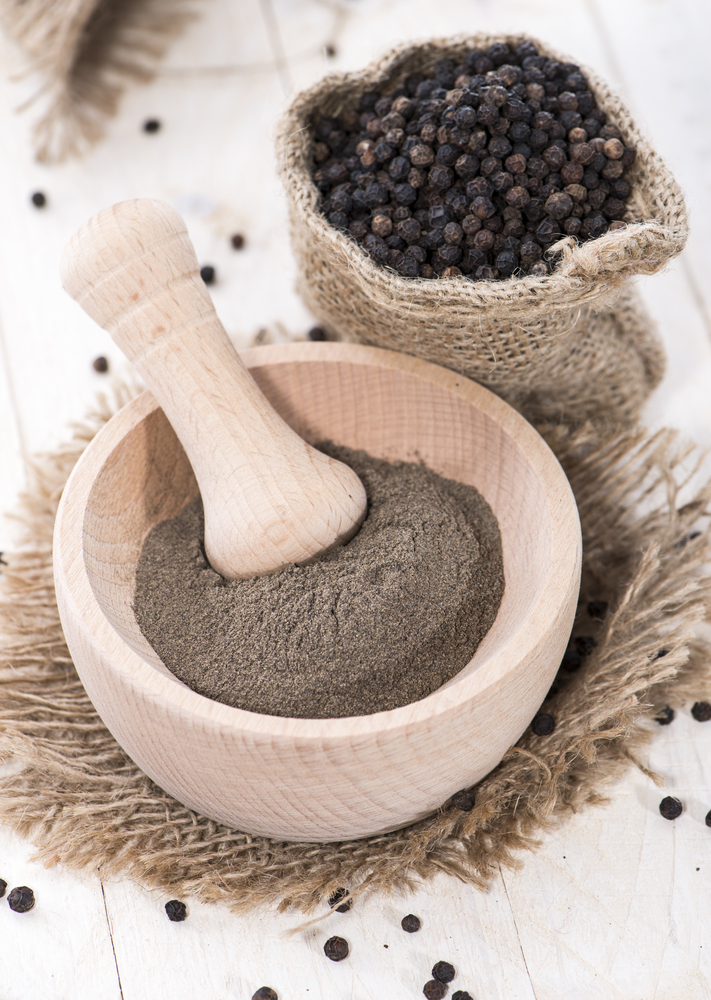
Black Pepper
Botanical Name: Piper nigrum Family: Piperaceae
Pepper is one of the oldest and best-known spices in the world. Indigenous to India pepper is popularly known as the King of Spices. From time immemorial, India has always reigned supreme in the production & export of this most exotic and renowned spice in the world.
Pepper plant is a perennial climber with dark green leaves and spikes of white flowers. The peppercorn is a berry like drupe, about ½ cm in diameter, green when unripe and then red. Black pepper comes from whole fruit, picked just before they are completely ripe and dried.
It is ideal for planting in the ground as well as in a container. Peppercorns are very strong in aroma and taste and can be stored for many years without losing its flavor. It is commonly used in all dishes as a very popular spice and in canned foods as a flavoring agent. It has medicinal properties for fighting colds, flu and infections, to energize, increase circulation, to warm and relieve muscle aches and stiffness etc.
The fruits are treated in many ways. The green fruits are sun dried for 7-10 days until the flesh around the single hard seed is wrinkled and become greyish black, then ground into black pepper or sold as whole peppercorns. The green pepper picked much earlier before ripening is air dried and used as such.
Harvesting Season: October – February
- MG1,
- TGEB & TGSEB
- Wayanad Pepper,
- Green Pepper In Brine,
- Freeze Dried & Dehydrated Green Pepper
Variety: Cracked, Coarse Ground, Ground, Fine Ground

White Pepper
Botanical Name: Piper nigrum Family: Piperaceae
White pepper consists of the seed only, with the skin of the fruit removed. This is usually accomplished by process known as Retting, where fully ripe berries are soaked in water for about a week, during which the flesh of the fruit softens and decomposes. Rubbing then removes what remains of the fruit, and the naked seed is dried.
Alternative processes are used for removing the outer fruit from the seed, including decortication, the removal of the outer layer from black pepper from berries through mechanical, chemical or biological methods.
White pepper is sometimes used in dishes like light-coloured sauces or mashed potatoes, where ground black pepper would visibly stand out. There is disagreement regarding which is generally spicier. They have differing flavor due to the presence of certain compounds in the outer fruit layer of the berry that are not found in the seed.
The main reason most cooks use white pepper is to maintain consistent color in light foods. Black specks in a perfectly prepared creamy white sauce are considered distracting. White pepper are also used in marinades or added to pickling spice.
Harvesting Season: October – February
- Muntok
- Sarawak
- Brazilian,
- Indian
Variety: Cracked, Coarse Ground, Ground, Fine Ground
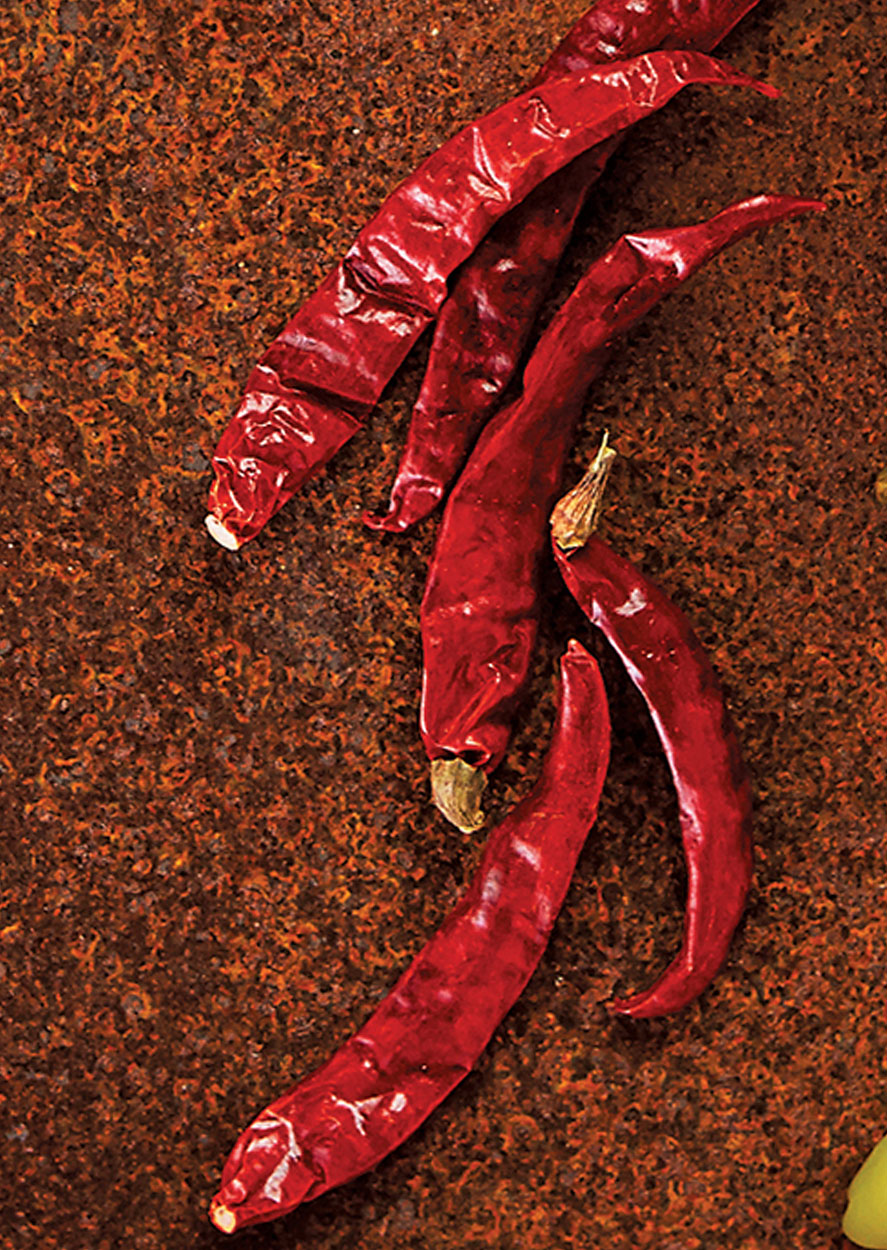
Chilies/ Red Pepper
Botanical Name: Capsicum frutescens Family: Solanaceae
An indispensable culinary spice, it comes in various shapes and colours. Chilli is the dried fruit of an annual sub-herb. It is also called as capsicum, paprika, sweet pepper, red pepper, pimento, cayenne pepper etc depending upon the manner in which it is prepared and used. Chilli comes in a wide range of shapes, sizes, color and degrees of pungency. Some varieties of chilli are highly pungent, medium pungent, others flavorsome but not pungent. Chilli is propagates by Seeds.
Chilli was introduced in India by the great Portuguese explorer Vasco-da-Gama. The spice chilli blended well in Indian cooking. Chilli became extremely popular in India. The climate in India was favorable to cultivate chillies and soon many varieties of chilli were available in India. Places like Andhra Pradesh, Tamil Nadu, Gujarat, and Kashmir became famous for different varieties in chilli. The highly pungent "Sannam" & the mildly pungent 'mundu' chilies are internationally popular varieties. India also offers 'gospurea chilli’. Byadgichillis are known for its high colour value.
AB Mauri has a well experienced chilli procurement team stationed at Guntur, Andhra Pradesh which is the largest chilli market in Asia. We have well-framed backward integrated farm contracts for IPM (PCP-Pesticide Control Program) chillies and organic chilli cultivation.
Chilli is one of the spices used most in garnishing dishes. Chilli is an indispensable spice used as basic ingredient in everyday cuisine all over the world. The chilli powder is made by crushing the dried chilli having chilli flakes and chilli pods.
The pungency of the chill is measure in Scoville scale. The hotness of the chilli is because the capsaicin present actually in the inner membrane placenta of the chilli and not in the chilli pods and chilli flakes as commonly believed. There are more than 400 varieties of chilli available all over the world. They differ in pungency, size, shape and colors.
Chilli found its way in ayurveda, the traditional Indian medical system .According to ayurveda, chilli has many medicinal properties such as stimulating good digestion and endorphins, a natural pain killer to relieve pains.
Harvesting Season: January – August
- Whole Red chilli
- Crushed Red Chilli
- Ground Red chilli,
- Oils & Oleoresins
Variety: Cracked, Coarse Ground, Ground, Fine Ground

Turmeric
Botanical Name: Curcuma longa Family: Zingiberaceae
Turmeric, the dried rhizome of a herbaceous perennial, is indigenous to Southeast Asia. The primary rhizomes, round in shape are called 'bulbs', while the thin, long secondary rhizomes are 'fingers'.
After harvest, the rhizomes are cleaned, boiled, dried and polished. Turmeric is closely related to ginger and is sometimes called Indian saffron due to its brilliant yellow color. The propagation of turmeric is by rhizomes. Turmeric is characterized with a fragrant, peppery aroma. It is slightly bitter in taste with a musky flavor.
In Ayurvedic practices, turmeric has many medicinal properties and many in South Asia use it as a readily available antiseptic for cuts, burns and bruises. It is also used as an antibacterial agent.
In medieval Europe, turmeric became known as Indian Saffron, since it was widely used as an alternative to the far more expensive saffron spice.
Erode, a city in the south Indian state of Tamil Nadu, is the world's largest producer and most important trading center of turmeric in Asia. For these reasons, Erode in history is also known as "Yellow City" or "Turmeric City".
Turmeric contains up to 5% essential oil and up to 5.5% curcumin, poly phenol (pH indicator). In turmeric most important for the aroma are Turmerone, turmerone, Zingiberene. Conjugated Diarylheptanoids are responsible for the orange colour and probably for the mild spicy taste.
Harvest Season : February - April
- Madras / Erode Turmeric
- Alleppey Turmeric
- Nizamabad Turmeric
- Vietnam Turmeric
Variety: Turmeric Fingers, Ground Turmeric, Oleoresin & Turmeric Oil
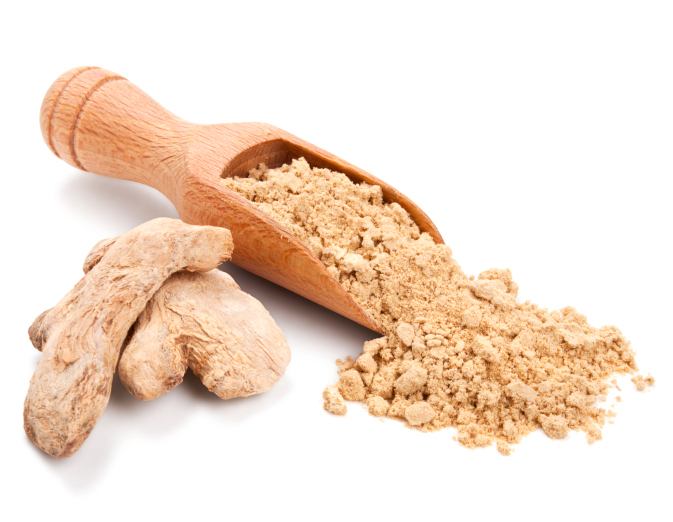
Ginger
Botanical Name: Zingiberofficinale Family: Zingiberaceae
Ginger is a tuber that is consumed whole as a delicacy, medicine, or spice. It is the rhizome of the plant Zingiberofficinale. It lends its name to its genus and family (Zingiberaceae). Ginger cultivation began in Asia and has since spread to West Africa and the Caribbean. It is sometimes called root ginger to distinguish it from other things that share the name ginger.
Ginger is the underground rhizome of a plant with Lanceolote leaves and spikes of yellow flowers, borne on stems. Dried ginger is obtained by peeling off the outer skin of the rhizome and drying in the sun after cleaning. Bleached ginger is obtained by coating the dried ginger with a solution of lime. The uncoated variety is called 'unbleached ginger'. Propagation of ginger is by portions of rhizome with one or two buds. The congenial climate and the rich healthy soil of Kerala help to produce the finest quality ginger in the world called the “Cochin Ginger”.
Fresh Ginger is extremely important in oriental and Indian food. It is used to flavour the cooking oil before you toss everything else for stir-frying. It is considered as a restorative, stimulant and a strong flavouring agent. Ginger is reputed to cure ulcers when chewed in small doses. It amply enhances your appetite when blended with other spices.
The characteristic odor and flavor of ginger is caused by a mixture of zingerone, shogaols and gingerols, volatile oils that compose one to three percent of the weight of fresh ginger.Young ginger rhizomes are juicy and fleshy with a very mild taste. Mature ginger roots are fibrous and nearly dry.
Ginger produces clusters of white and pink flower buds that bloom into yellow flowers. Because of its aesthetic appeal and the adaptation of the plant to warm climates, ginger is often used as landscaping around subtropical homes.
Harvest Season : February - April
- Cochin Ginger
- Calicut Ginger
- Nigerian Ginger
Variety: Ground Ginger, Sliced Ginger, Ginger Oil & Oleoresin
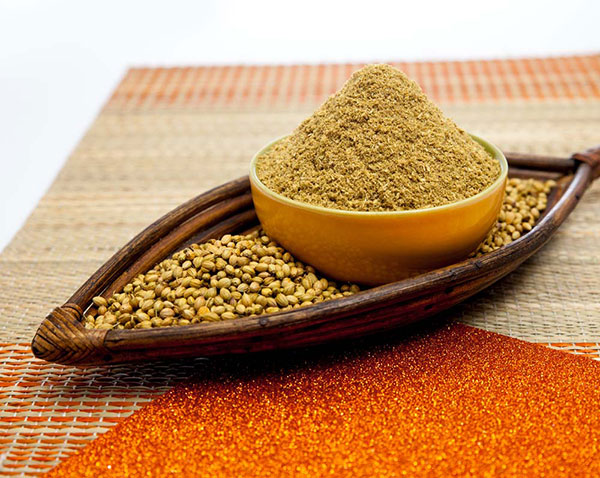
Coriander
Botanical Name: Coriandrumsativum Family: Apiaceae
Coriander is the dried fruit of an annual herb, with several branches and serrated leaves. The small flowers yield green globular fruits, which turn yellowish brown when ripe. The seeds are picked when the ripening is in progress and sun-dried. Coriander is pleasantly aromatic and flavorful. This fragrant spice is used for sauces and as a condiment. The fresh young leaves of this herb is used to flavour and garnish soups,salads and meat dishes.
Coriander is common in Middle Eastern, Central Asian, Mediterranean, Indian, South Asian, Mexican, Texan, Latin American, Chinese, African and Southeast Asian cuisine.
The dry fruits are known as coriander seeds or coriandi seeds. The word coriander in food preparation may refer solely to these seeds (as a spice), rather than to the plant itself. The seeds have a lemony citrus flavour when crushed, due to terpenes linalool and pinene. It is described as warm, nutty, spicy, and orange-flavored.
It is commonly found both as whole dried seeds and in ground form. Seeds can be roasted or heated on a dry pan briefly before grinding to enhance and alter the aroma. Ground coriander seed loses flavor quickly in storage and is best ground fresh.
Coriander seed is a spice ,ingaram masala and Indian curries, which often employ the ground fruits in generous amounts together with cumin. It acts as a thickener.
Harvest Season : March- April
Variety: Variety: Whole & ground forms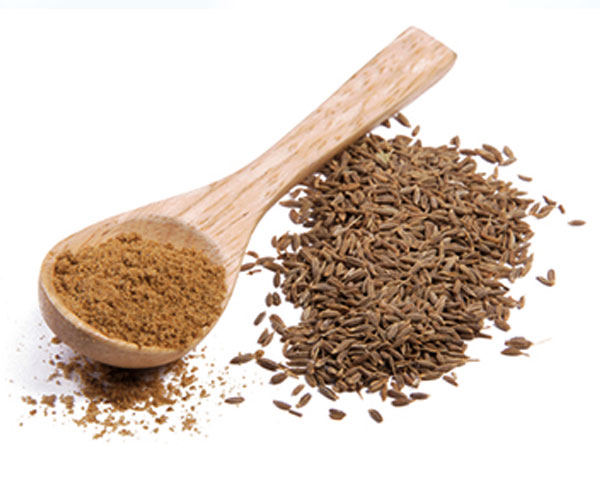
Cumin
Botanical Name: Cuminumcyminum Family: Umbelliferae
Cumin is the dried seed of the herb Cuminumcyminum, a member of the parsley family. Today, cumin is the second most popular spice in the world after black pepper. Cumin seeds are used as a spice for their distinctive aroma . Cumin's distinctive flavour and strong, warm aroma is due to its essential oil content.
It is a small herbaceous plant, cultivated for its dried fruits. At maturity the seeds are approximately 6 mm long, oval shaped, with pale green to yellow brown color. When the leaves with the seeds turn brown, the dried plants are collected, threshed,and seeds separated by winnowing. Cumin has an intensely strong and slightly bitter flavor.
Cumin is native to Egypt and has been cultivated in the Middle East, India, China and Mediterranean countries for millennia. Throughout history, cumin has played an important role as a food and medicine and has been a cultural symbol with varied attributes.
Cumin was mentioned in the Bible not only as a seasoning for soup and bread , but also as a currency used to pay to the priests. In ancient Egypt, cumin was not only used as a culinary spice, it was also an ingredient used to mummify pharaohs.
Cumin seeds were highly honored as a culinary seasoning in both ancient Greek and Roman kitchens. Cumin's popularity was partly due to the fact that its peppery flavor made it a viable replacement for black pepper, which was very expensive and hard to come by. Cumin was also noted for both its medicinal and cosmetic properties.
Harvest Season : March- April
- Indian cumin
- Syrian cumin
- Egyptian cumin
Variety: Whole & ground
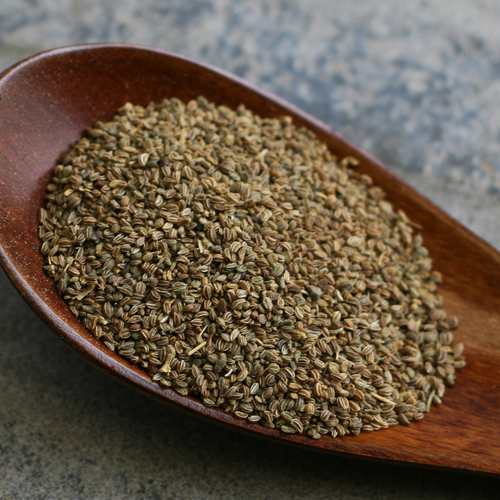
Celery
Botanical Name: Apiumgraveolens Family: Apiaceae
Actually very small fruit, these "seeds" yield a valuable volatile oil used in the perfume and pharmaceutical industries. They also contain an organic compound called apiol.
Actually very small fruit, these "seeds" yield a valuable volatile oil used in the perfume and pharmaceutical industries. Celery seeds can be used as flavouring or spice, either as whole seeds or ground and mixed with salt, as celery salt. Celery salt can also be made from an extract of the roots. Celery salt is used as a seasoning, in cocktails.
Celery is valuable in weight-loss diets, where it provides low-calorie dietary fiber bulk. Celery contains androstenone. There is a common belief that celery, being difficult for humans to digest, has negative caloric content because human digestion burns more calories than can be extracted from it. Celery seeds are also a great source of calcium, and are regarded as a good alternative to animal products.
Harvest Season : May
Variety: Whole & ground
Fennel
Botanical Name: Foeniculumvulgare Family: Apiaceae
It is a hardy, perennial,umbelliferous herb, with yellow flowers and feathery leaves. It is generally considered indigenous to the shores of the Mediterranean, but has become widely naturalised elsewhere and may now be found growing wild in many parts of the world, especially on dry soils near the sea-coast and on river-banks.
Fennel is a perennial herb. It is erect, glaucous green, and grows to heights of up to 2.5 m, with hollow stems. The leaves grow up to 40 cm long; they are finely dissected, with the ultimate segments are threadlike, about 0.5 mm wide. The fruit is a dried seed from 4–10 mm long, half as wide or less, and grooved.
Fennel is widely cultivated, both in its native range and elsewhere, for its edible, strongly-flavoured leaves and fruits, which are often mistermed "seeds". Its aniseed flavour comes from anethole, an aromatic compound also found in anise and star anise, and its taste and aroma are similar to theirs, though usually not as strong.
Fennel contains anethole, which can explain some of its medical effects: it, or its polymers, act as phytoestrogens. On account of its carminative properties, fennel is chiefly used medicinally with purgatives to allay their side effects, and for this purpose forms one of the ingredients of the well-known compound liquorice powder.
Harvest Season : March - April
- India
- Syria
